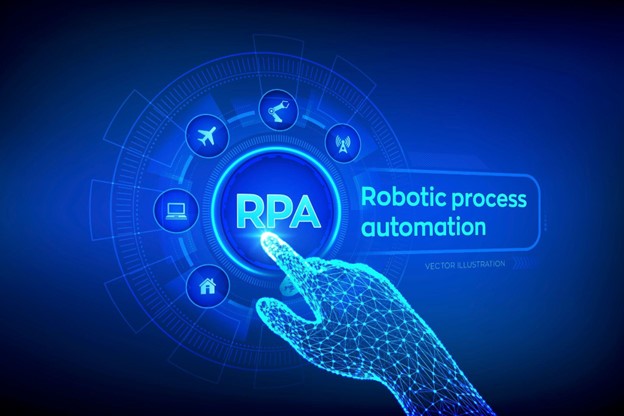
Robotic process automation (RPA) is an emerging form of business process automation technology based on the concept of digital workers, or software robots, that can perform tasks traditionally carried out by human beings. RPA systems are designed to automate repetitive, rules-based processes that are typically performed by human employees.
RPA can be used to automate a wide range of business tasks, including data entry, form filling, data mining and analysis, customer service, and even complex financial processes. RPA software robots can work alongside human employees or replace them entirely. In some cases, RPA systems are able to mimic the actions of human workers so convincingly that they can interact with customers and other business stakeholders without their knowledge.
RPA technology is based on the notion of digital workers, or software robots, that can carry out tasks traditionally performed by human beings. RPA systems are designed to automate repetitive, rules-based processes that are typically performed by human employees.
RPA systems are well suited for automating tasks that are highly structured and rules-based, such as data entry, form processing, and simple repetitive tasks. RPA can also be used to automate complex tasks that are currently performed manually by human employees, such as claims processing or contract review.
RPA systems can be deployed quickly and easily, with little or no upfront investment. Additionally, RPA systems can be easily scaled up or down to meet the changing needs of the business.
Benefits of Robotic Process Automation
Utilizing robotic process automation within your organization can provide a number of benefits, including:
Increased efficiency and productivity
RPA can help organizations improve their overall efficiency and productivity by automating routine, repetitive tasks that are typically performed by human employees.
Improved accuracy and quality
RPA can help improve the accuracy and quality of work by eliminating human error from the equation. Additionally, RPA systems can be configured to perform tasks in exactly the same way every time, ensuring consistent results.
Reduced costs
RPA can help organizations reduce their costs by eliminating the need to hire/train human employees to perform tasks that can be automated. Additionally, RPA systems can often be deployed at a lower cost than traditional solutions.
Improved customer satisfaction
RPA can help improve customer satisfaction by providing faster and more accurate results. Additionally, RPA systems can free up human employees to provide higher levels of customer service.
Improved compliance
RPA can help improve compliance by ensuring that tasks are performed in accordance with established rules and regulations. Additionally, RPA systems can provide an audit trail of all task execution, further enhancing compliance.
What Industries Can Utilize RPA?
Robotic process automation (RPA) can be used in a variety of industries, including:
- Banking and financial services
- Insurance
- Healthcare
- Manufacturing
- Retail
- Human Resources
- Telecommunications
- Utilities
In general, RPA can be used in any industry where there are routine, repetitive tasks that are currently being performed by human employees. RPA can also be used to automate complex tasks that are currently being performed manually.
What Are Some Examples of RPA?
Here are some examples of how robotic process automation (RPA) can be used:
Data entry
One common use for RPA is data entry. RPA can be used to automatically populate fields in online forms, such as customer information or product orders.
Form processing
RPA can also be used to automatically process forms, such as extracting data from forms and populating the data into a database.
Simple repetitive tasks
Another common use for RPA is to automate simple, repetitive tasks that are typically performed by human employees. For example, RPA can be used to automatically generate invoices or update customer records.
Complicated repetitive tasks
RPA can even be used to automate complicated, repetitive tasks that are typically performed by human employees. For example, RPA can be used to automatically process loan applications or review insurance claims.
How Can I Implement RPA?
If you’re interested in implementing robotic process automation (RPA), there are a few things you’ll need to do:
1. Define the scope of your project.
The first step is to define the scope of your RPA project. You’ll need to identify which tasks you want to automate and how you want the RPA system to interact with other systems.
2. Select the right RPA solution.
There are a variety of RPA solutions on the market, so it’s important to select the one that best fits your needs. Be sure to consider things like pricing, features, and support when making your decision.
3. Train your employees.
Once you’ve selected an RPA solution, you’ll need to train your employees on how to use it. This will ensure that they’re able to properly utilize the system and get the most out of it.
4. Implement the RPA solution.
After you’ve selected and trained your employees on an RPA solution, you’ll need to implement it. This typically involves installing the software and configuring it to work with your other systems.
5. Monitor and optimize the RPA solution.
Once you’ve implemented an RPA solution, you’ll need to monitor it and optimize it over time. This will ensure that the system is working properly and that you’re getting the most out of it.
Conclusion
Robotic process automation (RPA) is a powerful tool that can be used to automate a variety of tasks. When implemented properly, RPA can help improve efficiency and productivity while reducing costs. If you’re interested in implementing RPA, be sure to follow the steps outlined above and consult with an RPA expert.
